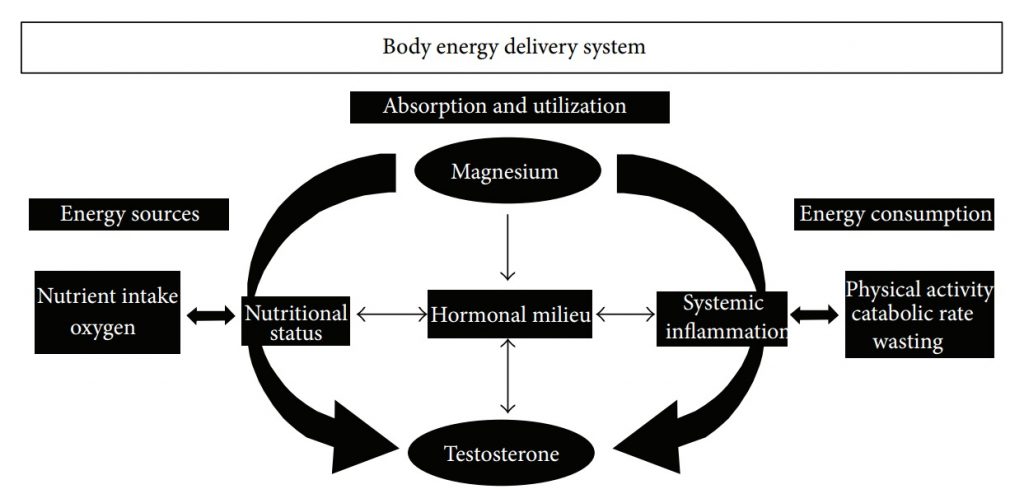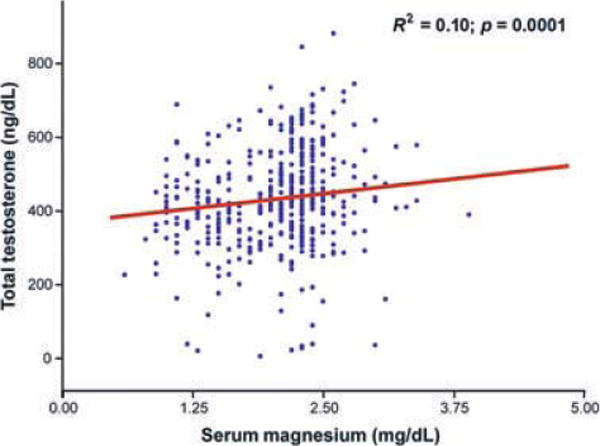Multi-purpose mineral may help with T and anabolic muscle gains in both elderly and athletic men.
![By Jurii (http://images-of-elements.com/magnesium.php) [CC BY 3.0], via Wikimedia Commons](https://supplementsinreview.com/wp-content/uploads/2016/07/Magnesium-2-300x300.jpg)
- Inhibit sex hormone binding globulin (SHBG). The primary offender against active T levels, SHBG is “blocked” by Mg’s electrostatic modulation of the T-SHBG bond.
- Reduce oxidative stress. Mg protects against T-killing inflammation/oxidative induced by aging & exercise.
- Promote anabolic homeostasis. Of the 300 hormonal/enzymatic functions facilitated by Mg, many help operate & build muscle.
Overview
Working as the 11th most abundant mineral in the body, Magnesium (Mg) is a major compound involved in a number of biochemical reactions, including protein synthesis, muscle contractions, nerve conduction, blood pressure, heart rhythm, blood glucose regulation, and more. Considering its diverse roles in over 300 bodily functions, Mg is both an incredibly simple and absurdly complex mineral:
- Simple because you simply cannot function without it.
- Complex because most magnesium is in bone or in cells, making it difficult for us to assess & define an appropriate “Magnesium status.”
Yet, we’re certain that there does exist an appropriate “Magnesium status” due to the vast collection of clinical data in support of Mg intake and, more importantly, against Mg deficiency. And, unfortunately, if you’re wondering whether or not you’re Mg deficient, most likely you are: Nearly 70% of adults are below the recommended daily intake of Mg, with 19% adults consuming less than half the recommended amount.1
The issues involved with Mg deficiency include:
- Metabolic Syndrome
- Diabetes (Type 2)
- Depression
- Anxiety
- Migraine
- Atherosclerosis
- Osteoporosis
And, yes:
- Low T Levels

In terms of boosting testosterone, Magnesium seems to work similarly to another important manly mineral Zinc:
- Having inadequate amounts of either mineral correlates with significantly decreased T levels, whereas increasing intake beyond adequate levels has little positive effect.
In other words: There’s a threshold amount of Mg required for optimum testosterone health.
Odds are, if you’re consuming a typical Western diet, your Mg levels are below that threshold. Additionally, similar to Zinc, Mg is easily secreted from the body through sweat, putting Western athletes at an even higher risk of Mg deficiency–and, consequently, low T.
But what’s Mg’s connection with T? Let’s find out:
How Magnesium Might Help T
Inhibits SHBG
Remember all of those bio-chemistry terms from high school that you forgot about?
Van der Waals interactions. Hydrogen bonding. Thermodynamics.
Turns out there was a point for studying them: They apply to Mg’s inhibitory role against sex hormone binding globulin (SHBG). Unlike traditional SHBG blockers, Mg frees T from this protein not by binding it to another compound, but through modulating the electrostatic attraction that facilitates the bond between T and SHBG.
Through uncompetitive inhibition of Mg on T-SHBG bonds, T’s affinity to SHBG is altered, resulting in more bioactive T in the bloodstream.3
Reduces Oxidative Stress
One of the negative modulators of T status is inflammation–namely inflammatory cytokines, which act as inhibitory factors on the pituitary gland (decreasing secretion of Luteinizing Hormone–responsible for signaling T production) and directly on the testes (where T production occurs).
During systemic inflammation, both T and Mg levels are diminished.4 Yet, supplementing Mg has shown to help T status by reducing the resulting oxidative stress damage afforded by inflammatory cytokines. Whether Mg’s antioxidant capabilities include anti-inflammation as well remains relatively unknown–however, inflammation seems to decrease in the presence of Mg, which may be attributed to T’s anti-inflammatory effects.5
Promotes Anabolic Homeostasis

The obvious observation: Mg regulates over 300 pathways, therefore low Mg inevitably leads to disrupted T production–plus, many more health issues. Throughout the aging process, a number of factors interrupt the cascade of nutritional/hormonal pathways required of an anabolic metabolism (including T production). Having an adequate supply of Mg can help mediate those pathways to ensure a functional anabolic homeostasis is achieved.5
Research
Animal Research
Animal trials have the unique advantage of controlling both Mg deficiency & excessive Mg intake to observe their effects on male sex hormones, functions, and behaviors. In regards to low serum Mg levels, researchers found that:
- Cells along the epididymis (tubes that connect the testes to the vas deferens) had a “peculiar response” to the absence of adequate Mg levels. This was held in comparison to the belief that Mg-deficiency is associated with increased oxidative stress in the testes.7
Whether this supports the notion that Mg-deficiency correlates with oxidative stress seems unclear—yet, under conditions of excess Mg intake, researchers observed:
- Increased serum T levels
- Less sperm degeneration
- Higher LH levels, but unaffected FSH
- Decreased oxidative stress in testicular tissue8
In this last study, Mg supplementation seemed to have both indirect and direct action on testicular function, with at least an improvement on oxidative stress levels. More importantly, these pre-clinical animal studies show promise for Mg’s clinical usage on male health.
Human Research
Human trials on Mg supplementation show promising T-boosting results, particularly among active athletes—however, older men at risk of Mg depletion seem to benefit from supplementation as well.
In this study, the combined effects of Mg & exercise on free & total plasma T levels were assessed on two tae kwon do groups (one with Mg supplementation; one without) and a sedentary (no exercise with Mg supplementation) control group. During research, T levels were determined at 4 different stages: 1) Rest before supplementation, 2) Exhaustion before supplementation, 3) Rest after supplementation, 4) Exhaustion after supplementation.
- The researchers concluded that “supplementation with magnesium increases free and total testosterone values in sedentary and in athletes.” Furthermore, “The increases are higher in those who exercise than in sedentary individuals”–the combination of Mg & exercise resulting in 24% increased total T.9
Serum Magnesium levels positively correlate with anabolic growth hormones and total T in older men.

This cohort study was the first attempt to establish an association between Mg and anabolic hormones in a large sample (n = 399) of older men (aged > 65). The research compiled and compared analyses on the subjects’ serum levels of testosterone, total IGF-1 (growth hormone factor), sex hormone binding globulin (SHBG), dehydroepiandrosterone sulphate (DHEAS), and serum Mg levels in an effort to find any correlations between the mineral and male hormones.
- In conclusion, magnesium levels were “strongly and independently associated with the anabolic hormones testosterone and IGF-1”—however, as the researchers pointed out, this was a preliminary analysis and therefore no direct causality between Magnesium and hormones could be conclusively determined.10
Zinc Magnesium Aspartate (ZMA) might promote free testosterone and anabolic muscle gains.
The (in)famous article that started it all, Dr. Lorrie Brilla’s and Victor Conte’s double-blind, randomized study on ZMA (30 mg zinc monomethionine aspartate, 450 mg magnesium aspartate, and 10.5 mg vitamin B6) supplementation for athletes brought ZMA into the sports nutrition limelight. Combining the leading male-support attributes of zinc and magnesium (with a little extra B6 boost), ZMA theoretically aids athleticism by promoting T levels and anabolic muscle gains.
- After that theory was put to the test on NCAA football athletes, the researchers concluded that “ZMA supplementation was associated with improved anabolic hormone profile and muscle function in already strength-trained varsity collegiate football players.” Thus lending more credit to Mg’s use in an athletic regimen.11
However, bear in mind that not all research is in support of ZMA’s anabolic, T-boosting effects. Later studies have reported that “ZMA supplementation during training does not appear to enhance training adaptations in resistance trained populations.”12 However, this seems to have less to do with the merits of ZMA and more to do with athletes’ initial mineral levels prior to ZMA supplementation.
Dosage Notes
Is there a “correct” Magnesium dosage?
Not really… Usually, by trial-and-error your personal “correct” Mg dosage can be found, but, in general, start with the Recommended Daily Allowance measures:
- ~400 mg per day for men
- ~310 mg per day for women
Then move up from there. The tae kwon do study supplied around 1000 mg per day to achieve Mg’s T-boosts, so there’s plenty of room to increase your dosage, if need be.
Side Effects
While the mineral holds a low toxicity profile, Mg side effects are Extremely Common—albeit commonly mild. Most side effects fall within the range of:
- Nausea
- Cramps
- Low BP
- Diarrhea
- Soft Stool
For many, the last two side effects (Diarrhea & Soft Stool) are the intended functions of their Mg intake—usually in an effort to remedy constipation or cleanse the colon. If these side effects are unwanted, avoid supplementing too much Mg (perhaps holding off on Mg supplements temporarily if you feel you’re acquiring adequate dietary Mg).
Available Forms
In addition to the natural sources of Magnesium (green veggies, nuts, beans, whole grains, etc. etc.), there are numerous forms of Mg supplements—some offering unique advantages. The most common forms include:
- Magnesium Amino Acid Chelate. The mineral chelate form of Mg involves the connection of an ion of Mg oxide to an amino acid. For the best chelated amino acid Mg, look for magnesium aspartate or arginate.
- Magnesium Oxide. Cheap Mg that’s the worst, yet (unfortunately) the most used. Has a high Mg concentration, but an extremely low bioavailability (4%).
- Magnesium Citrate. Derived from the Mg salt of citric acid, Mg Citrate is one of the most potent forms of Mg—ranking higher than amino acid chelate Mg and Mg oxide in terms of bioavailability.13
- Magnesium Orotate. Often cited as the best form, despite no scientific evidence of orotic acid aiding the absorption of minerals. Mg Orotate seems to be a premium form of Mg, but this might be partly due to its heavy price-tag.
- Magnesium Sulfate. Best known as Epsom salts, Mg sulfate has a strong laxative effect and is often added to baths as a muscle relaxant (most notably recommended by the notorious Dr. Oz).
- Magnesium Chloride. Commonly found in topical lotions, gels, and oil preparations. Mg chloride has many nutritional and industrial uses, including manufacturing paper and coagulating tofu.
- Magnesium Carbonate. Contains antacid properties and nearly 45% Mg concentration. Often used as a “chalky” drying agent for bodybuilders’ and gymnasts’ hands.
- ZMA. Victor Conte’s sports nutrition trio of Zinc Monomethionine Aspartate, Magnesium Aspartate, and Vitamin B6 (as Pyridoxal HCl). Look for ZMA upgraded to Zn Citrate, Mg Citrate, and B6 as P-5-P.
Supplements in Review Recommendation
- Magnesium Citrate, 600 mg per day (by Trial-and-Error)
Magnesium boosts T to a degree. In reality, Mg isn’t so much of a “T-booster” as it is a “T-restorer.” On that note, supplementing Mg beyond that Mg threshold won’t increase your T beyond normal levels, but considering how prevalent Mg deficiency is, we might as well consider it as a T-booster–especially for mature men and athletes.
For some, 600 mg is too much Mg. For others, it’s not enough. Determining adequate Mg levels is notoriously complicated, but do your best to monitor your intake to avoid the “Extremely Common” side effects of too much Mg. But remember: Upwards of 70% aren’t getting enough Mg. Odds are that includes you.
References
Leave a Reply